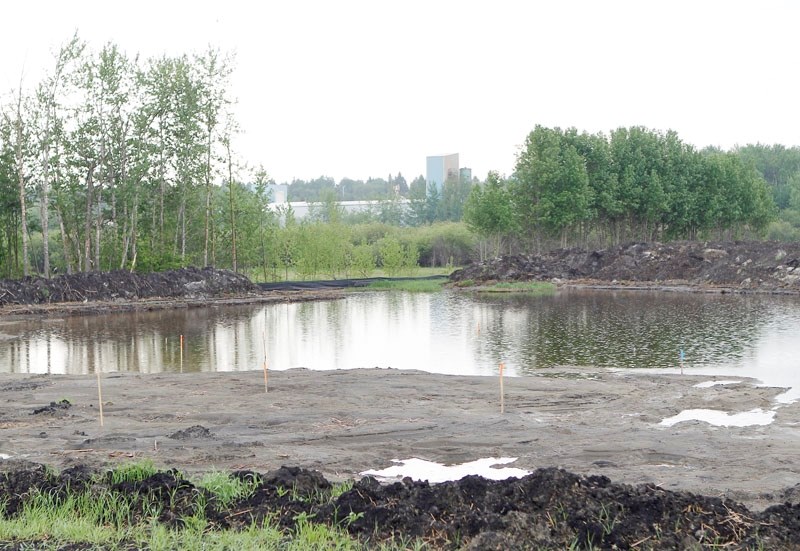Spring floods have swamped a stormwater pond under construction on the banks of the Sturgeon, and local environmentalists fear that the river’s fish may have been harmed as a result.
St. Albert’s Environmental Advisory Committee learned last week that Alberta Environment was looking into a stormwater management facility under construction as part of the Riverside subdivision near Meadowview Lane and the Sturgeon River. The pond is being built on behalf of Reid Worldwide Corp. as part of a 122-lot neighbourhood.
The pond (which is actually two ponds connected by a channel) is within the Sturgeon’s 1:100 year flood plain, said city community sustainability manager Leah Kongsrude – a region developers are discouraged from building in due to the risk of floods. The land-use bylaw does permit stormwater ponds in the flood plain, she noted – the city built three of them as part of Ray Gibbon Drive – and this pond was approved for construction by the city.
Reid Worldwide’s crews started work on the pond in March, said Greg Hembroff, the company’s vice-president of planning. They had planned to be done by April, but got delayed due to unexpected soil conditions. “We had all our approvals in place.”
On May 8, a St. Albert resident canoeing past the Riverside site saw that it was completely underwater and contacted the city.
The canoeist, whom the Gazette agreed not to name in order to protect her job, said she saw that a large amount of dirt had been placed on the banks of the Sturgeon. “The water was basically flowing on either side of this soil, and there was a large amount of soil being washed into the river.”
The water was about a metre deep in this region, the canoeist said, and had turned the one- to two-metre tall dirt piles into islands. “There was nothing between the water and the soil.” She did not do a water quality test to determine the effect of the dirt on the river.
Sediment is considered a deleterious substance under the federal Fisheries Act, Kongsrude said, “especially at this time of year, because our northern pike are spawning.” The act forbids the deposition of those substances in waters frequented by fish. City crews are required to take extensive steps to prevent sediment from running off of construction sites into the Sturgeon.
Dirt from the Riverside pond site may have harmed fish by smothering eggs and clogging gills, Kongsrude said. It would be up to Alberta Environment to determine if this had, in fact, occurred.
While the city reviews but does not provide advice on the specifics of construction plans, Kongsrude said her department gave the nod to this project on the assumption that construction would occur during the winter using best-management practices. “It doesn’t look like they followed best-management practices.”
Those practices say you shouldn’t plan construction in a flood plain during a river’s high water period, she explained, which is from April 15 to May 15 for the Sturgeon, unless you had excellent flood prevention plans. “You want to wait until that ground is frozen.” Construction in the river itself is banned between April 15 and June 30. In this case, crews appeared to have started construction very close to flood season.
This was not a major flood, Kongsrude noted. “We didn’t even have a 1:100 year flood.”
Alberta Environment officials were looking into this matter, said spokesperson Renee Hackney, and the pond’s builders had hired a consultant to address erosion issues. The department had yet to determine if a formal investigation was needed.
The site is still flooded, Hembroff said, with work halted until the province gives them the go-ahead to resume. He was not sure what effect this would have on construction timelines.
Ken Crutchfield, a member of the Environmental Advisory Committee and a retired chief fisheries officer with Alberta Fish and Wildlife, said he was disappointed when he learned about this flood and concerned about its effects on fish habitat. “It’s poor planning.”
This was a known flood plain with known risks, he said, and the proponents here should have taken steps to address those risks. “These guys clearly didn’t,” he said. “They shouldn’t have started (construction) in March. They should have started in December.”




